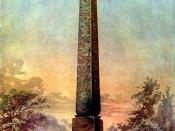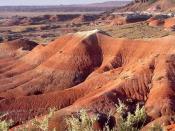Cleopatra's needles are two of the twenty-six obelisks in the world today. Egypt gave the Cleopatra's Needles to U.S. and Britain. They are in Victoria Embankment, London, England and Central Park, New York, U.S., today.
The Painted Desert is a beautiful plateau and desert region containing buttes, mesas, pinnacles, hills, and valleys. Wind and rain formed these by eroding. Since there is not much vegetation, wind and rain erode hills quickly. Erosion studies have shown that steep slopes loose as much as one-forth of soil each year. Even though it sounds small, geologically it is very rapid. It is located in Arizona, but some people include it with Utah deserts. It begins about thirty miles north of Cameron and goes southeast for about 200 miles. The Little Colorado River marks its southern boundary; while, the Hopi Mesas make up the northern edge. The Painted Desert was named The Painted Desert because when early Spanish explores came, they called it El Desierto Pintado which translated into The Painted Desert.
It was called that because of the heat, light, and dust that changed the colors of the desert. The colors that change are oxides of iron, hematite aluminum, red sediment, yellow sediment, and bentonite clay. The colors change the most is at sunrise or sunset. Cacti, small-leafed shrubs, rattlesnakes, kangaroo rats, roadrunners, ringtails, and deer mice live in the arid parts. In the soil, cyanobacteria, lichens, mosses, green algae, microfungi, and bacteria live here, too. Some amphibians such as spadefoot toads are also found in the park. Reptiles such as the collared lizard are found in the desert, too. Painted Desert is a rare desert that changes colors.
Cleopatra's Needles are made of red granite and was made for monuments to the sun god Re by Egyptian people in Ancient Egypt.


